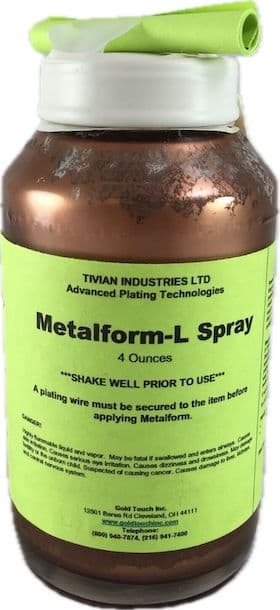
Curated with aloha by
Ted Mooney, P.E. RET

How do you electroplate non-conductive items like flowers, animal skulls, and plastics?
Readers may recognize that flowers and bone and plastic are non-conductive, whereas electroplating will require that the surface of the object be made conductive. So one of the first steps required will be to 'metallize' the object to make it conductive.
In some cases this can be as simple as painting the object with a copper-based or silver-based paint ... and we should keep it simple if we can :-)
But there are instances where they just won't cut it. Think about shiny automotive grills -- virtually all are chrome plated plastic. They must endure scrub brushes in car washes and gravel hits on the highway, but the truly difficult problem is the temperature range from frigid northern winters to blistering desert sun. The plastic expands much much more than the rigid metal plating, and the plastic and plating would quickly separate and the plating peel off if paint were the metallization technique. If you need outstanding adhesion between the plastic and the plating, you need a different approach than conductive paint: see thread 31550, "How high quality plating on plastics is done".
In between the very simple painting method and the quite complex method used for automotive grills, are four other metallization approaches that we're aware of, for a total of six; you'll choose one depending on the nature of the substrate and the end use of the item:
- The easiest to understand approach was mentioned first: simply painting the items with a paint that contains metal particles or flakes, usually copper, silver or zinc.
- You can apply a spray of colloidal conductive material, either carbon or metal. This is not very different than the first approach except that the particles are extremely fine, and the process is designed specifically for the purpose of allowing fine decorative plating onto non-conductors.
- There are solutions designed for brushing onto ceramics and then firing in an oven. The familiar gold edging you would see on fine china is an example.
- Two-part silvering solutions are used for many different applications including plating of lacquer masters for vinyl records. You simultaneously spray a soluble silver salt and a reducing agent in order to reduce silver metal directly onto the item in question. This is essentially the same method (Brashear process) used to make mirrors.
- The fifth method is vacuum metallizing. Under high vacuum metal is evaporated, and deposits onto the item you want to metallize. This requires a vacuum chamber, so it's probably not useful for hobbyists. Vacuum metallizing is more often a competitor to plating than a metallization technique before electroplating.
- The sixth and most complex method is the one usually done for plating on plastics: after a special etch of the material to give it a sponge-like outer surface, you dip it into stannous chloride or palladium chloride, or both in sequence, and then use the conductive seeds that you have thus formed as the nucleating points for electroless copper or electroless nickel deposition. This is usually a high volume industrial process and invariably relies on proprietary chemistries available from the major suppliers, but offers the advantage of a truly robust process for difficult environments like the previously mentioned automotive exterior brightwork.
It is good to remember that metallization is a carefully honed art; if you are trying to plate flowers or leaves and so on, don't expect to get the same kind of results in early trials as are achieved by artisans who have been working for decades to perfect their trade.
You also should realize that plating chemicals can be aggressive, and you will probably have to develop some techniques with wax or lacquers to keep the plating chemicals from attacking the organic materials. If the item is important to you, don't try to plate it until you are good at it. You will see plated flowers and leaves and such stuff for sale on the web; try search terms like "gold plated orchids".
A vocabulary note: the word "electroforming" is sometimes used as an alternate to "electroplating" when discussing this kind of work. It's actually the same process, but when you are putting a metal coating onto an object it's called electroplating. When the metal you are depositing actually becomes the object of interest, and what you plated it onto becomes of no consequence, it's called electroforming -- for example, when you make gold teardrop earrings by doing heavy gold plating onto wax pieces of teardrop shape.
